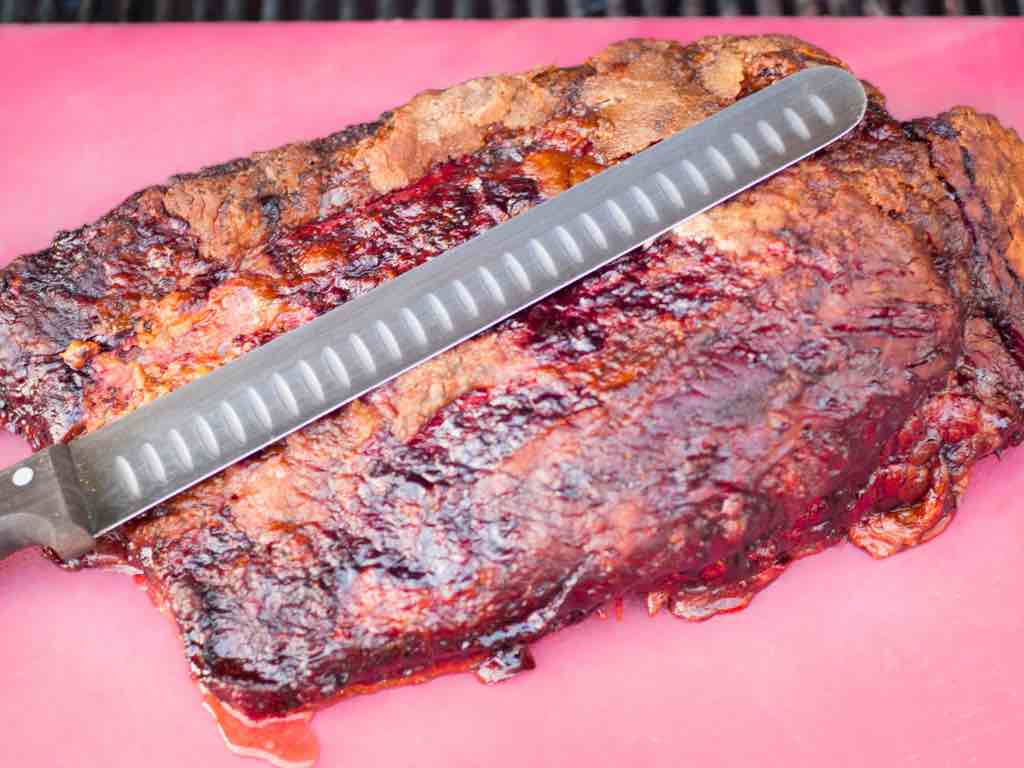
The Brisket Knife: The Key to Precise Slicing and Culinary Excellence
|
|
Time to read 7 min
Welcome to One Stop Halal!
Written by: Imran Shaikh
|
|
Time to read 7 min
In the world of barbecue and culinary arts, the right tools are paramount for achieving exceptional results. When it comes to slicing brisket, having a quality brisket knife can make all the difference. This blog will explore the brisket knife's significance in slicing this delectable cut of meat. We will delve into the anatomy of the perfect brisket knife, its key features, the different types available, and the importance of using the right knife for the task. Join us as we uncover the secrets to precise slicing and culinary excellence with the ultimate brisket knife.
The anatomy of a brisket knife is carefully designed to meet the specific requirements of slicing this delectable cut of meat with precision and ease. A quality brisket knife typically consists of three essential components: the blade, the handle, and the bolster.
The Blade: The blade of a brisket knife is characterized by its long, narrow profile, measuring between 10 to 14 inches in length. This extended blade allows for smooth, even strokes along the length of the brisket, resulting in clean and consistent slices. The elongated blade also minimizes the number of strokes required to cut through the entire brisket, enhancing efficiency and control. Many brisket knives feature a granton edge, which includes hollowed-out indentations along the blade's sides. These indentations create air pockets between the blade and the meat, reducing friction and preventing slices from sticking to the knife. The granton edge design promotes seamless cutting and ensures that each slice of brisket is effortlessly separated from the blade.
The Handle: The handle of a brisket knife is essential for providing a comfortable and secure grip during slicing. It is usually constructed from durable materials like wood, stainless steel, or synthetic materials. The handle's ergonomic design allows for precise control and reduces hand fatigue, making it easier to navigate the knife through the dense meat.
The thoughtful combination of these components in a brisket knife ensures the ultimate slicing experience. A well-designed brisket knife not only enhances the appearance of the sliced brisket but also preserves its texture and flavor. For any pitmaster or barbecue enthusiast looking to elevate their slicing technique, investing in a quality brisket knife with the right anatomy is essential for achieving culinary excellence.
The importance of a best brisket knife in the world of barbecue and culinary arts cannot be overstated. A dedicated brisket knife is specifically designed to achieve precise and effortless slicing, making it a valuable tool for any pitmaster or chef working with this tender and flavorful cut of meat.
In conclusion, the importance of a brisket knife lies in its ability to enhance the slicing process, present the brisket attractively, retain its juiciness and flavor, and demonstrate a commitment to professional culinary performance. Investing in a quality brisket knife is an investment in culinary mastery, leading to beautifully sliced, succulent, and mouthwatering brisket that impresses both chefs and diners alike.
There are several brisket knife types available, each designed to suit different cutting preferences and techniques. Understanding the various types of brisket knives can help pitmasters and chefs choose the perfect tool for achieving precise and effortless slicing:
Ultimately, the choice of brisket knife type depends on personal preferences, slicing techniques, and the desired cutting results. Each type of knife offers unique features that cater to different cutting styles, allowing pitmasters and chefs to select the perfect tool for achieving their desired brisket slicing outcome.
Welcome to your favorite butcher shop. We carry custom cuts of beef, chicken, lamb, goat, grass-fed beef, wagyu, deli, and more. We ship across the United States in 1-2 business days.
Properly caring for your brisket knife is essential to maintain its performance, longevity, and safety. Here are some important tips to keep your knife in top condition:
By following these care tips, you can extend the life of your knives for brisket and ensure it remains a reliable and effective tool for slicing delicious brisket for years to come. Regular maintenance and proper handling will keep your knife in top shape and contribute to a more enjoyable and safe slicing experience.
A brisket knife is a specialized tool that plays a pivotal role in the art of slicing brisket with precision and finesse. Its long, narrow blade, granton edge, and ergonomic handle design are essential for achieving even slices of tender, mouthwatering brisket. Whether you're a barbecue enthusiast or a professional chef, investing in a quality brisket knife is an investment in culinary excellence and the satisfaction of serving beautifully sliced brisket that will impress any guest at your next barbecue gathering. Choose the perfect brisket knife, and elevate your slicing technique to new heights of culinary mastery.

© 2026 One Stop Halal, Inc.